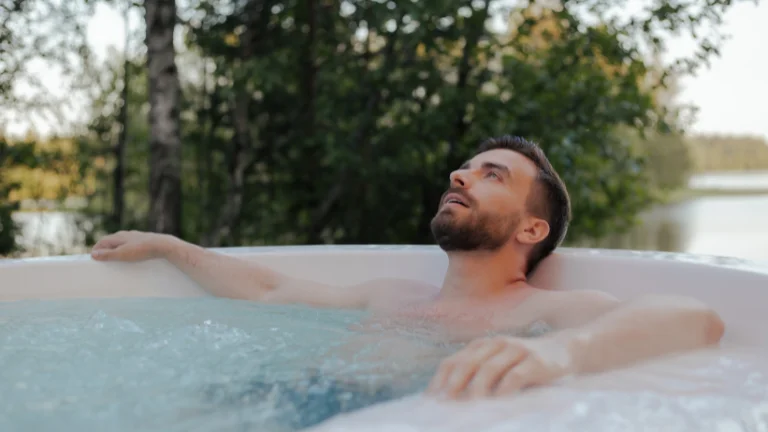2-Person Hot Tub 220 Volt: Compact, Energy-Efficient Relaxation
Searching for the perfect 2-person hot tub can feel like a daunting task, especially when space is tight, and energy efficiency is a priority.
If you’re eyeing a 220-volt model, you’re likely focused on finding a hot tub that not only fits your compact space but also offers the relaxation and therapeutic benefits you’re after—all without sending your energy bills through the roof.
Whether you’re dealing with the constraints of a small backyard or looking for an easy-to-install option, you’ve come to the right place. In this guide, I’ll explore the best solutions to these common challenges, ensuring you find the ideal hot tub that meets your needs and enhances your outdoor oasis.
2-Person Hot Tub 220 Volt:
If you’re seeking a hot tub that combines space-saving design with energy efficiency, a 2-person 220-volt hot tub could be your ideal choice. These models offer a range of benefits tailored to smaller outdoor spaces while ensuring optimal performance and comfort.
Benefits of 2-Person 220-Volt Hot Tubs:
- Compact Size: Fits well into smaller patios or backyards, perfect for limited spaces.
- Efficient Heating: Heats up quickly and maintains temperature better, making it ideal for colder climates.
- Simultaneous Operation: Runs both jets and heater on high simultaneously for a more enjoyable experience.
- Energy Savings: Improved heating efficiency can lead to lower energy costs over time.
| Feature | 110V Hot Tubs | 220/230V Hot Tubs |
|---|---|---|
| Setup | Plug-N-Play, no wiring | Requires professional wiring |
| Heat Time | Slower, less efficient | Faster heating |
| Simultaneous Operation | No (jets or heater only) | Yes (both jets and heater) |
| Cost | Lower (no installation) | Higher (installation cost) |
| Portability | High (easy to move) | Low (fixed installation) |
220-volt hot tub ensures that you can enjoy a warm, soothing soak with minimal space and energy concerns. Whether you’re looking to optimize your outdoor area or seeking a high-performance hot tub, this option strikes the perfect balance between convenience and efficiency.
Understanding 220-240V Hot Tubs
While 110V hot tubs offer convenience and lower initial costs, 220-240V hot tubs provide superior performance and energy efficiency, making them a better choice for those who use their hot tub regularly.
Voltage Requirements
When deciding between a 110V and a 220/240V hot tub, understanding the voltage requirements is crucial. Here’s a breakdown:
- 110V Hot Tubs: These are often labeled as “Plug-N-Play” models, meaning they are designed for ease of use. They can be plugged into a standard outlet with minimal setup. They typically use 20 or 30 amp breakers and do not require professional installation. However, their power limitations restrict the simultaneous use of high-powered features like jets and heaters.
- 220/240V Hot Tubs: These require a dedicated 50 amp GFCI breaker and professional wiring, including installing a new circuit. Although this setup involves higher upfront costs and more complex installation, it offers significant advantages in performance and efficiency.
Differences Between 110V and 220V Hot Tubs
| Feature | 110V Hot Tubs | 220/240V Hot Tubs |
|---|---|---|
| Power Source | Standard outlet | Dedicated electrical circuit |
| Breaker Amperage | 20-30 amps | 50 amps |
| Installation | Plug-N-Play, no professional installation required | Requires licensed electrician for wiring |
| Heating Time | Slower, up to 24 hours | Faster, up to 4 times quicker |
| Simultaneous Operation | Jets or heater, not both | Both jets and heater can run simultaneously |
| Cost | Lower (no installation fees) | Higher (installation costs) |
| Size and Features | Limited jets, smaller sizes | More jets, larger sizes |
Why 220-240V is More Energy-Efficient for Frequent Use
220-240V hot tubs heat water significantly faster than 110V models. This efficiency means less time spent heating and more immediate enjoyment. They also handle simultaneous operation of jets and heaters without strain, making them ideal for frequent use. The faster heating reduces the overall energy consumption by decreasing the time the heating element is active, which can lead to lower energy bills over time.
Choosing the Right Type of Hot Tub for Your Needs
When selecting the decision between a 110V Plug-N-Play model and a 220V/230V model can significantly impact your enjoyment and maintenance. Here’s a detailed comparison to help you choose the right type for your needs.
110V Plug-N-Play vs. 220V/230V Models
- 110V Plug-N-Play Models
- Pros:
- Easy Setup: Simply plug into a standard outlet, no professional installation is required.
- Portability: Lightweight and easy to move, making it suitable for renters or those who frequently rearrange their outdoor space.
- Lower Initial Cost: No extra charges for electrical work.
- Cons:
- Limited Power: Can only run jets or heater on high, not both at the same time.
- Slower Heating: Takes longer to reach the desired temperature, especially in colder weather.
- Fewer Features: Generally has fewer jets and smaller size options compared to 220V models.
- Pros:
- 220V/230V Models
- Pros:
- Enhanced Performance: Ability to run jets and heater simultaneously, offering a more enjoyable experience.
- Faster Heating: Heats up much quicker, reducing wait time and improving energy efficiency.
- More Features: Typically larger with more jets and advanced features.
- Cons:
- Higher Initial Cost: Requires professional installation and a dedicated electrical circuit, which adds to the upfront cost.
- Installation Complexity: Involves additional work for wiring and setup, requiring a licensed electrician.
- Pros:
When to Choose a 220-Volt Model for Better Heating and Jet Performance
Opt for a 220V/230V hot tub if:
- Frequent Use: You plan to use your hot tub regularly and want consistent, efficient heating.
- Enhanced Experience: You prefer the ability to use both jets and heater simultaneously for a superior soaking experience.
- Colder Climates: You live in an area with cold winters and need a hot tub that can heat up quickly and retain heat effectively.
The Difference Between 110V and 220V/230V Hot Tubs
The primary difference lies in power and performance:
- 110V Hot Tubs: Convenient and cost-effective but limited in power and feature set.
- 220V/230V Hot Tubs: Provide superior performance with faster heating and the capability to run multiple features simultaneously, making them ideal for frequent use and larger setups.
For more information on choosing the right hot tub and to explore options, check out our detailed guide on 220V/230V hot tubs.
Determining the Ideal Hot Tub Capacity
Ultimately, selecting the right hot tub capacity depends on balancing your space constraints with your needs and preferences. Whether you opt for a compact 2-person model or a more spacious 4-person hot tub, choosing the right size will ensure you get the most enjoyment and value from your investment.
2-Person vs. 4-Person 220 Volt Hot Tubs
- 2-Person Hot Tub
- Benefits:
- Compact Size: Perfect for smaller spaces like small patios or balconies, making it a great option if you have limited room.
- Energy Efficiency: Typically uses less energy to heat and maintain, which can help keep operating costs lower.
- Personal Comfort: Ideal for couples or small families who prefer a more intimate setting.
- Ease of Installation: Requires less space and often simpler installation compared to larger models.
- Benefits:
- 4-Person Hot Tub
- Benefits:
- Larger Capacity: Accommodates more people, making it suitable for families or small gatherings.
- Enhanced Features: Often includes more jets and advanced features for a more luxurious experience.
- Versatile Use: Ideal for socializing or therapeutic use with additional seating and space.
- Benefits:
Benefits of a 2-Person Model for Small Spaces
- Space-Saving Design: Fits into tighter areas without overwhelming your outdoor space, perfect for urban or smaller properties.
- Cost-Effective: Generally less expensive both in terms of purchase price and ongoing operational costs.
- Simplicity: Easier to install and maintain, especially if space constraints limit access for installation and maintenance.
How to Choose Based on Available Space and Intended Use
- Available Space: Measure your outdoor area to ensure you have enough room for the hot tub and any additional space needed for access and maintenance.
- Intended Use: Consider how many people will regularly use the hot tub and for what purposes. A 2-person model is ideal for personal relaxation or a couple, while a 4-person model is better for hosting friends or family.
- Design and Features: Think about the features you want, such as the number of jets or additional amenities. Larger models may offer more features but also require more space.
What to consider:
When choosing, it is important to consider the following factors:
- Size: Make sure the hot tub is big enough for you and your partner to relax comfortably.
- Jets: The number and type of jets will affect the massage experience.
- Features: Consider other features such as a heater, ozone generator, and safety cover.
- Budget: Hot tubs can range in price from a few hundred dollars to several thousand dollars.
Benefits
It is an ideal investment for any home. Here is just an occasion of the advantages of owning one:
- You’ll save money on your energy bills. A 220-volt hot tub uses less energy than a standard 120-volt model, so you’ll see monthly savings on your utility bills.
- You’ll enjoy hotter water temperatures. Because it uses more power, it can heat water to higher temperatures than a 120-volt model. This means you can enjoy a longer, more relaxing soak in it.
- You won’t have to worry about voltage drops. When large appliances run on the same circuit, the voltage can drop and cause problems with performance. With a 220-volt, you won’t have to worry about this happening since it will run on its dedicated circuit.
- You can use more energy-efficient equipment. Since a 220-volt uses more energy, you can purchase more energy-efficient equipment that will cost less over time and provide better performance.
Disadvantages
When it comes to hot tubs, people often think bigger is better. However, there are some disadvantages to having it. For one thing, they can be more costly to operate. Additionally, more minors may need to be more energy efficient. Finally, they can take up more space in your home.

Key Features to Consider: Number of Jets and More
By understanding these key features, you can make a more informed decision about the best hot tub to meet your needs and ensure a satisfying and efficient hot tub experience.
Number of Jets
- Impact on Massage Quality and Relaxation:
- More Jets: A higher number of jets typically translates to a more intense and satisfying massage. This can enhance relaxation by targeting various muscle groups more effectively.
- Jet Strength: The quality of the massage is not just about the number of jets but also their strength and placement. A well-designed jet configuration can offer a more customized and enjoyable experience.
- How Jet Configuration Enhances Therapeutic Benefits:
- Varied Configurations: Different jet types and placements can address specific therapeutic needs. For instance, jets positioned at various angles can target sore muscles and provide relief.
- Adjustability: Many hot tubs allow you to adjust the intensity and direction of jets, which can enhance the overall therapeutic experience.
For detailed guidance on selecting the best jets for your needs, check out our How to choose hot tub jets article.
Heating Time
- How 220-Volt Systems Reduce Heating Time:
- Faster Heating: 220-volt hot tubs heat water significantly faster compared to 110-volt models. This efficiency is due to the higher power capacity, allowing for quicker temperature adjustments and more immediate use.
- Consistent Comfort: A 220-volt system ensures that the water remains at a comfortable temperature even during extended use or in colder weather.
- Energy Savings and Comfort During Cold Weather:
- Lower Energy Costs: Faster heating means the hot tub runs for a shorter period, reducing overall energy consumption and operating costs.
- Improved Heat Retention: Effective heating helps maintain a consistent temperature, enhancing comfort and efficiency, especially in colder climates.
Breaker Amperage and Electrical Requirements
- What to Expect When Wiring a 220-Volt Hot Tub:
- Dedicated Circuit: A 220-volt hot tub requires a dedicated electrical circuit with a 50-amp GFCI breaker. This setup ensures safe and efficient operation.
- Professional Installation: Wiring a 220-volt hot tub involves installing new wiring and a dedicated breaker, which typically requires a licensed electrician.
- Average Cost to Hire an Electrician for Installation:
- Installation Costs: On average, hiring an electrician to install a 220-volt hot tub can range from $900 to $1500. The final cost depends on factors such as the distance from the electrical panel, local labor rates, and any additional construction needs.
Should You Get a 110 or 220 Volt Spa?
By considering both the initial installation costs and long-term benefits, you can make an informed decision on whether a 110V or 220V hot tub best suits your needs and lifestyle.
Installation Costs
- Comparing the Setup Costs:
- 110V Models: These are typically less expensive to install. They can be plugged into a standard outlet, so you avoid the need for professional wiring. This makes them a cost-effective option for those who want a straightforward setup.
- 220V Models: Installation is more complex and costly. You will need a dedicated circuit and a 50-amp GFCI breaker, which usually requires a licensed electrician. The average installation cost ranges from $900 to $1500, depending on factors like distance and local labor rates.
- Long-Term Energy Savings:
- 220V Systems: Although the initial installation cost is higher, 220V hot tubs are generally more energy-efficient in the long run. They heat up faster and use less energy over time, which can lead to lower utility bills compared to 110V models. The faster heating also means your hot tub operates for fewer hours, reducing overall energy consumption.
Fun Factor and Enjoyment
- How Higher Voltage Enhances the Overall Hot Tub Experience:
- Increased Performance: 220V hot tubs offer enhanced performance with the ability to run both jets and heater simultaneously. This feature allows for a more enjoyable and consistent soaking experience.
- Better Features: These models often come with more jets, advanced features, and larger sizes, providing a more luxurious experience and accommodating more people.
- User Reviews and Experiences:
- 220V Models: Many users report a more satisfying hot tub experience with 220V systems. The faster heating time, ability to use jets and heater together, and overall better performance contribute to higher satisfaction. Reviews often highlight improved comfort and greater enjoyment, making 220V models a preferred choice for those who use their hot tub frequently or entertain guests.
If you want to enjoy a hot tub but avoid dealing with the installation hassle, you can carry it when you travel and enjoy all the benefits of a relaxing soak. Some people believe hot tubs are necessary for any home, while others find them expensive.
Related Articles:
Coleman SaluSpa E02 Code Error Fixing:
This article provides a comprehensive guide on troubleshooting and fixing the Coleman SaluSpa hot tub’s E02 code error. It outlines step-by-step instructions and offers practical solutions to resolve the error, ensuring a smooth and enjoyable tub experience.
The Period in Hot Tub: Is it Safe to Swim in a Hot Tub?
Is it safe to swim in a hot tub while on your period? This article explores the topic, addressing common questions and concerns regarding menstrual hygiene, water sanitation, and potential risks.
For additional information, visit Hot Tub Patio. if you’re interested in reading reviews and guides for hot tubs, visit Hot Tub Guides and Reviews.
FINAL WORDS
After reading this article, you should better understand small 220-volt hot tubs. We hope that this guide has been helpful in your decision-making process and that you feel more confident about which route to take when powering your new hot tub.
Common Queries:
Is a 220-volt hot tub more efficient? Generally, a 220-volt hot tub can be more efficient than a 110-volt one. This is because higher voltage allows for faster heating and better performance, resulting in less energy consumption.
Do hot tubs take 220V? Yes, many hot tubs are designed to operate on 220 volts. This higher voltage is commonly used to power larger hot tub models.
Is 110 or 220 better for a hot tub? Regarding performance and efficiency, a 220-volt system is generally considered better for a hot tub. It allows for quicker heating, more powerful jets, and better overall performance than a 110-volt system.
Are all hot tubs 240 volts? Not all hot tubs require 240 volts. While many larger models do operate on 240 volts, smaller models are also available that can run on 120 volts.
Is 220 volts a lot of electricity? The voltage itself does not determine the amount of electricity consumed. Voltage refers to the electrical potential, whereas the amount of electricity used is measured in watts or kilowatts. The amount of electricity used depends on the power consumption of the device or appliance.
Does a hot tub use much electricity? Hot tubs can consume significant electricity, especially if used frequently. Energy usage depends on factors such as the size of the hot tub, insulation, heating system, and usage patterns. It is recommended that you consider the hot tub’s energy efficiency and operational costs before purchasing.
Which countries use 220 voltage? Several countries worldwide use 220 volts as their standard voltage, including most European countries, Australia, Russia, China, and many others. However, it’s important to note that voltage standards may vary within countries or regions.
Which is cheaper, 110V or 220V? The cost difference between 110 and 220 volts primarily depends on the specific situation and location. Regarding electrical installation, 220-volt systems may require additional wiring and equipment, which can increase upfront costs. However, regarding operational efficiency, 220 volts can be more cost-effective due to higher energy efficiency and faster heating times.
Which country uses 220V? Many countries use 220 volts as their standard voltage, including but not limited to Germany, France, the United Kingdom, Australia, China, Russia, Brazil, India, and South Africa. It is always advisable to check the specific voltage requirements of a country before traveling or using electrical devices internationally.












